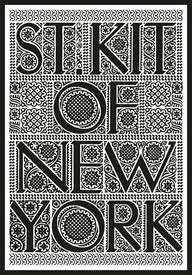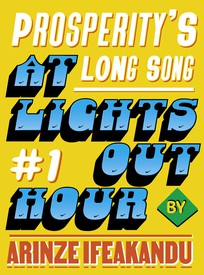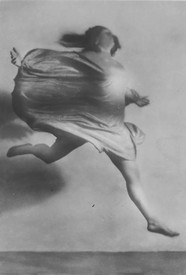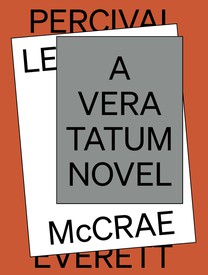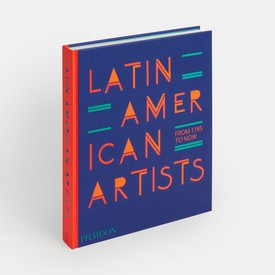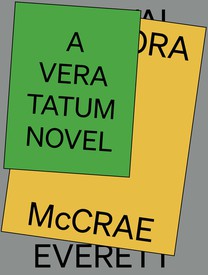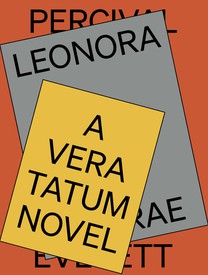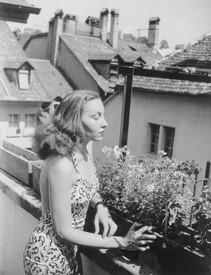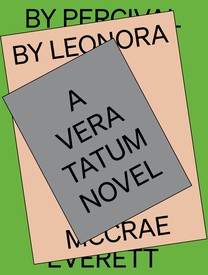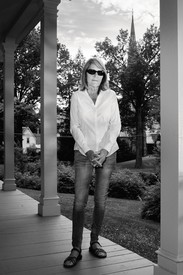
Christopher Bollen is the editor-at-large of Interview magazine. His third novel, The Destroyers, was published by Harper Publishing in June 2017. Photo: Sébastien Botella
Part Four
“Oh, it’s beautiful,” Kit said unconvincingly.
She sat on the arm of a leather sofa, her bare legs goose-bumped from the blast of an entirely-too-low air-conditioning unit, her face and neck beaded with sweat from the record-high temperature of late spring in Manhattan. Standing before her in the spacious hotel room was Ronell Stephens’s mother, Alice. The attractive older woman wore the same lavender suit she’d sported the night Kit first met her, at the basement prayer meeting celebrating Kit’s miracle painting. The lavender suit must be Alice’s best outfit—or her only outfit, as far as Kit knew; she’d only laid eyes on the woman these two times. All Kit really knew about her was that her son had been convicted of homicide.
“Absolutely stunning,” Kit exclaimed more loudly, as if volume could be confused for sincerity. “All the sparkles! How creative!”
The madness of the moment overwhelmed Kit as she faked a smile and adjusted her perch on the sofa arm. It was as if she had been suddenly asked to identify herself in a police lineup. She couldn’t recognize her own life—not to point to it with certainty and proclaim, Yes, that’s the one. How did she get here? What had she become? A month ago she’d been minding her own precious business, painting portraits of unknown murderers and enjoying the success of a rising-star artist. Since her painting of Ronell had magically sprouted tears, she’d been dropped from her gallery, turned into tabloid fodder, visited a maximum-security prison, appeared on two morning talk shows to lecture a blinking camera about the inherent racism of the US judicial system, and, oh, yeah, had her life threatened by the revenge-seeking son of the cop Ronell had allegedly shot to death. It was that last item that had brought on bouts of queasiness about the plan for today. Mateo Esposito, who had already tried to bash her head in with a baseball bat, was out there somewhere on the loose. The police had been unable to find him. He was out there with god knows what arsenal of weapons, and in one hour Kit was scheduled to speak alongside Alice at a rally at City Hall, demanding the reopening of Ronell’s case. In other words, she’d be a squawking sitting duck (or standing, really), ripe for Mateo’s aim. Kit had rented this hotel room for Alice as a gift. It was two blocks from the rally, so Alice didn’t have to worry about traveling from the outer boroughs on top of everything else. Nearly a thousand protesters were expected to besiege the courthouse steps this afternoon, many of them from Alice and Ronell’s Queens neighborhood, many others from the Manhattan art world, where Kit had suddenly become a symbol of resistance.
Kit assumed that the robe Alice was currently presenting to her in the middle of the hotel room was her idea of a thank you. The robe was hand stitched, covered in shiny black sequins, and lined with fake black mink fur. Alice held it out and shook it as if tempting a bull to charge her. It was the ugliest piece of clothing Kit had ever had the misfortune of beholding.
“I made it for you myself,” Alice said, with pride and raised eyebrows. Her lavender eye shadow matched her suit. “For you to wear today at the rally for Ronell.”
“Oh,” Kit moaned. “I couldn’t. I couldn’t possibly.” She struggled for a reason other than vanity (which had always been reason enough, as far as Kit was concerned). “It’s so eye-catching, it will steal the attention away from Ronell, from our message!” Kit thought this excuse rather coherent considering she had had all of five seconds to invent it. Alice’s face deflated, her eyebrows dropping and the lavender eye shadow shrinking into squinted folds. Kit glanced at her friend Bruce, who leaned against the hotel door right next to the emergency escape-route map. Kit had brought him to serve as her support system—she could always trust her friend’s sarcastic pragmatism to keep her feet glued to the ground. Surely he wouldn’t want her draped in black sequins in 100-degree heat delivering a speech about police brutality? Kit imagined explaining the outfit to her great-
grandchildren while watching some future version of YouTube.
Bruce’s only reaction was a fond nod. She grunted at his unhelpfulness and rotated her eyes back onto Alice.
“Does it look too much like a judge’s robe?” Kit asked. “I don’t know if we should encourage references to authority figures.” Kit had purposefully chosen to wear a simple green shirt and skirt—pale cadmium #084 in her box of oil paints—because of the color’s vaguely militant, Viet Cong, camo-uniform associations. The tucked-in blouse and tight-at-the-waist skirt also flattered her thin frame.
“I thought of it more like a choir robe,” Alice replied, delicately bunching the synthetic fabric. “The rest of us will be wearing our choir robes. Yours is the only one with sequins. Because you’re the one who made all of this possible for Ronell. The beads will catch the sunlight just like you’re a saint.” Tears streamed down Alice’s cheeks and disappeared into the creases of her broad smile. Crying while smiling always reminded Kit of those times growing up in the suburbs of Baltimore when it rained while the sun shone. She rose from the sofa and grabbed the robe.
“Let me try it on.” She nodded at Bruce to follow her into the adjoining bedroom. Alice’s two older sisters sat on the bed, also dressed in pantsuits of Easter egg pastels. Between them were a number of open photo albums starring Ronell as an infant and a toddler. There were even a few loose shots of him in junior high school—right up to the point of puberty and, presumably, the moment he started to involve himself in more criminal after-school interests. Ronell had admitted being a drug dealer when she visited him in prison.
The sisters turned from their knee-to-knee huddle and stared up at Kit with adoration. The bedroom offered no privacy for a candid talk with Bruce, so she opened the bathroom door and waved him in. Before she closed the door, she caught Alice’s face in the outer room, watching her with apprehension. Alice Stephens’s son had dealt drugs and may or may not have shot an undercover narcotics officer. But she disapproved of a young woman entering a bathroom with an older man—even if Kit happened to be paying for the hotel room, even if Bruce happened to be a fifty-year-old gay man who bragged about not knowing the names for most parts of the female genitalia. Kit slammed the door shut.
Alice’s makeup tubes were spread across the counter. Bruce pressed his knuckles on the marble countertop and stared at her in the mirror. She searched for his sarcastic smile but couldn’t locate it. To induce that smile, she waved the robe in her fist.
“Maybe if it were bullet-proof I’d consider it,” she whispered. “But, my god, look at it! Sequins! What was she thinking? I’ve finally found my breaking point. It wasn’t the death threats. It’s this robe.”
Bruce wasn’t smirking, only watching her soberly in the mirror. Kit turned and grabbed him by the shoulder.
“What’s wrong with you?” she asked. “Let me guess. You think it’s perversely chic!”
He didn’t laugh but kept his eyes trained on hers.
“What difference does it make?” he asked.
“Easy for you to say when you don’t have to be caught—”
“Kit, you’re talking like this is still about you.” Bruce’s cement-fixed gaze on her face was starting to spook her, as if she should have heeded Alice’s warning about locking herself in a small, confined space with him. “Why not wear it if the poor woman wants you to? After all she’s given you. . . . ”
“Given me?” She took a step back. “Don’t you mean, all I’ve given her? All I’ve done, all I’ve thrown away—”
“She’s given you the opportunity to change,” he said, as his hands mimed a cable breaking between them. “Who gets that chance? Are you completely blind? You have the chance to make a real impact, to give people a belief in something more than they’ve ever been offered anywhere else. Kit, don’t waste it. Please don’t.”
Only when Bruce pinched his eyelids did she realize he’d been crying. What was it about this hotel room that caused everyone who set foot in it to break down? Kit also only realized when he wiped his tears away that her friend was not the same hilarious, hedonistic socializer she’d known for a New York eternity.
“Do you think I want to continue on like I have?” he asked. “To be that man for the rest of my life? To sleep with any young person who’s willing to say yes to me? To consider it an achievement if I don’t start drinking until noon? To be writing articles about twenty-year-old painters who think they’re the next de Kooning even though they only learned who de Kooning was a year ago? To be the walking, talking, sighing joke in every room?” He shook his head as if to answer the questions for her. “I’m not alive to be someone’s amusing lunch partner. This situation with your painting has woken something inside of me, and I don’t want it to go back to sleep again. Kit, I’m asking you to take what you’re doing seriously. I need to believe that it’s possible to change, that a hand can reach out in life and shake you. This miracle is bigger than you are. Don’t ruin it. Let people have their hope.”
Right up until that moment in the bathroom, Kit had mistaken the crying painting for her story. In the back of her mind, she had assumed that once this weird season was over, she’d return to her art career and its cocktail parties, and an August vacation at Bruce’s house in San Sebastián, and a future of pretty women and men as lovers, and the hope that one day this entire bizarre interlude might inspire a clever series of canvases. At most, Kit thought the incident was a test of her character—never a test of her herself. But as she stared at the reflection of her friend sobbing into his hands in the mirror, she finally understood that it mattered very little what Kit Carrodine felt about anything that had happened. This wasn’t her story; she was merely its instrument.
“Oh god,” she wheezed, staring into the sink.
Bruce put a hand on her back. “What’s wrong?”
She wanted to tell him, Oh god, she’s gone. The old Kit I was is gone. Instead she said, “Nothing,” and slid her arms into the robe.
Downtown Manhattan boiled in the heat. That Saturday noon, most of its gummy sidewalks were deserted—the residents who hadn’t escaped the island for cooler shores were taking refuge from the hot snap in their air-conditioned apartments. But the park and streets at City Hall were crammed with the angry and the faithful. They were of all ages and skin colors. The estimated 1,000 attendees had swelled to 2,000, and many brandished signs or posters or T-shirts of Kit’s now iconic Untitled, #7 showing Ronell Stephens. Others carried water pistols that had initially been intended to symbolize police violence but were used instead to relieve the crowds with cascades of water.
On a different day, Kit might have recalled that these courthouse steps were the same ones where not long ago her ex-boyfriend Kai had garbled a mention of their getting married. “Uh, you know, we should do it one day, it’d be so quick,” he’d said, as if quickness were the chief selling point. “We could do it right here at City Hall and bring one friend as a witness. You know, because I want to be with you. Think about it. Seriously. Are you hungry? Tacos?”
Kai’s squeamish nonproposal had been the actual deathblow to their relationship. Kit couldn’t continue to date a man who even unrealistically fantasized about making her a wife. She’d broken up with him a few weeks later, right before her painting started weeping at Haskell Vex’s gallery. That seemed so long ago now—almost another planet ago, another universe. As Kit mounted the steps alongside Alice Stephens, she wasn’t thinking of Kai. A young poetess activist with dyed-white dreadlocks introduced Kit, “the painter of miracles,” and handed her a bullhorn. She spoke into it to the thousands of faces in front of her, some weeping, some nodding devoutly, some chanting her name. Kit was here to give people the hope they’d been longing to taste their whole lives. Manhattan had once been a city of transformation, and she’d prove that it was possible for this soulless shopping complex to transform again. All could be reborn here, shaking off one existence for the fresh skin of another. A photojournalist knelt before her to snap pictures as she spoke, her arms moving through the sequined folds as if she were swimming in black, moonlit water. Hundreds of phones recorded her every movement and word. On the screens she appeared as a shining column of light.
“I cannot say if my painting is a divine or an earthly act, but I will say with absolute assurance that we can change ourselves into agents of good. We can perform a human miracle. We can think collectively instead of individually and make amends for the sins we’ve caused. Who among us feels they can take another step in this same, dead direction?” Noooooo, went the crowd’s roar in response. “We start over as one right now! We start by releasing Ronell Stephens from prison today!” Cheers erupted across the park. The frail metal gates that separated Kit from the multitudes were beginning to buckle with the press of bodies. Kit fed the crowd that was feeding her. She demanded an official response from the mayor and the resignation of the district attorney. Then she grabbed Alice’s hand and hoisted their arms high in the air. “This is what solidarity looks like,” she promised. Why had no one told her this fundamental secret: the answer to pain wasn’t all those years alone in her studio trying to create meaning from art; the answer was this tight clench of hands, this soft embrace of people, this gathering together under the open sky. Nothing had ever made her feel so alive. She offered Alice the bullhorn.
“They want to hear from you,” Kit said. She ceded the steps to Ronell’s mother.
It was only once on the sidelines, listening to Alice describe the state’s murky evidence against her son, that Kit processed the full intensity of the crowd. Like running her fingers across smooth wire only to hit upon a sharp barb, she stared out at the faces and envisioned Mateo, her assassin, somewhere in the crush. She was so vulnerable on these steps, within mere arm’s reach of anyone, and she noticed very few police officers in sight. In any case Kit doubted the cops would do much to protect her, since she was, in effect, asking for the release of a man convicted of killing one of their own. Fear began to burrow into her brain. She imagined a bullet striking her chest, or a hammer blow to the back of her skull. Kit had too much to live for, too much to do—she felt she’d only just woken up to the world.
A teenager in a wheelchair was pushed toward the metal gates, a Japanese boy with twisted legs and a twisted spine. Kit bent over the gate to touch her palm to his chin. The boy seemed to appreciate the attention, and his father thanked her behind his thick glasses.
“I’m so glad you two could make it,” she said as she stood up. That’s when she caught a flurry of movement shooting toward her from deep in the crowd. Bodies were shifting around some advancing force, the way stalks are swept aside when an animal charges through a field of corn. An instinct told Kit that she was in danger. She stumbled back from the gate and gathered the hem of her robe to hop up the courthouse steps. Aware that she was now standing too close to Alice in the middle of her speech, accidentally hogging someone else’s spotlight, Kit hurried across the steps. She spotted a figure darting through the congested front section to intercept her on the other side. It must be Mateo, she thought. Here, finally, was the son of Anthony Esposito to take her life in exchange for his. It was too good a life to lose.
Kit climbed over the security gate and entered the squeeze of bodies. Hands reached out like branches in a forest to shield or scratch her. “Excuse me,” she said politely, “please let me through.” But Mateo Esposito was not far behind, she could feel it, so she dug through the people—her people—shouting less politely, “Excuse me! Out of the way! I need to get through!” The sequined robe was too obvious of a target, for Mateo and for every single protester hoping to soak up her spirit by skin-to-skin contact. Kit yanked the dense fabric from her body, and as she slipped between two sweaty, heavyset men as stationary as sequoias, the robe came loose from her grip. At least she looked like a civilian again, anonymous and free.
She made it out of the park and into the far street, where there was room to maneuver. In the corner of her eye, though, she still saw the figure chasing behind her. She dodged a pretzel vendor and two black children hugging a Great Dane, and nearly lost her balance as she stumbled over a sidewalk curb. The young man in pursuit was temporarily corralled by the Great Dane’s leash. Kit found herself at the entrance to the uptown subway, and without thinking she dove down its steps to disappear deep inside the earth. Knocking against riders exiting the station, she raced to the turnstile, jumped it, and sprinted for the car doors.
She was too late. The steel doors shut in her face. She chased after the retreating train until it was swallowed by the tunnel. Kit’s run sputtered out as she reached the end of the waiting platform. Down here, in the balmy winds of the underground, where the horrors of the city scavenged for food in the trash cans and scurried with long pink tails on the tracks, she had hit a dead end. How could she be so stupid after so many years in Manhattan surviving on her wits? As she turned around, she nearly accepted her fate. The man who had been chasing her passed through the turnstile and started his approach down the deserted station. Kit stood her ground. At least Mateo would have to walk the forty feet to kill her. She wouldn’t meet him halfway.
“Kit,” the man hissed. “Why the hell were you running?”
The monotone voice was so familiar—so specific to eighteen months of her previous life—that her fear turned into an admixture of happiness and rage. The man wearing ratty gray sweat shorts and a paint-flecked tank top, now the length of a public bench away from her, wasn’t Mateo Esposito. It was her ex-boyfriend. Kai’s face was hollow in the cheeks and swollen in the eyes. A recent haircut hadn’t eased the sharp desperation of his features. In other words, Kai looked exactly like the man who had spent the past month phoning Kit at her studio, begging for a chance to win her back. Thanks to her assistant, Grace, she’d avoided all of his calls. She had so many other hearts to fill now that his seemed claustrophobic by comparison. How had she fit inside it for even a day, let alone eighteen months?
“I’ve tried to talk to you so many times,” Kai said.
“I know. But it wouldn’t have done any good. We’re never going to get back together. I’m not even the same person you shared an apartment with. I’m sorry.”
“It’s not that,” he scoffed. It might not have been that, but clearly a second dose of rejection stung. Kai rolled his eyes and, in hurt, studied the grimy wall tiles. “I felt guilty. I felt like I owed you an explanation or an apology. But look at you now. Celebrity miracle worker. I caught your interview on TV. Christ, Kit, are you aware of what a fool you’ve become? The Kit I knew would have preferred a razor blade to the wrist.”
Kit took a patient breath. “I accept that you’re hurting,” she said, “but you don’t owe me any apologies or explanations. You weren’t a bad boyfriend. What you need to know is that I’ve changed.” Now she wished she hadn’t removed the robe. Kai always did learn best by visual evidence. “I’ve taken a new path. For whatever reason, I’ve been chosen to help heal the wounds of the world.”
For a moment, Kai nodded respectfully. But his respect was a show, and he followed it up with mocking, sniggering laughter. He strapped his arm over his stomach and bent into it. “You’re hilarious. You were chosen?”
“I don’t expect you to believe me. It doesn’t matter if you do.”
“Because of the tears on that painting?” Kai stepped forward, his chin raised and his jaw clenched. “I did that! I put those tears there! That was me!”
Kit couldn’t absorb this information. She tried to picture Kai summoning the telekinetic power of automatic tears on inanimate objects. He must have caught the look of confusion on her face. “It’s a chemical compound one of my science friends whipped up. It’s a gel that secretes water over time. I went into Haskell’s gallery right after you dumped me, chose one of your prisoners at random, and smeared it on the eyes. It was revenge!”
“Revenge?” Kit repeated almost soundlessly. In her shock, she was still trying to comprehend the chemical compound part. She was still trying to comprehend the That was me part—which meant, That wasn’t her, which meant, That wasn’t some divine spirit who chose Kit Carrodine specifically to be a guiding force.
“You didn’t cry,” Kai shouted. “You didn’t cry once when we broke up. I think I even saw you smile when you turned away. You were so thrilled to be rid of me. You couldn’t even bother with tears. I don’t know why that surprised me. All you ever cared about was your work. So I decided to make one of your paintings cry!”
There had been no miracle. The entire last month had been a joke. There had been nothing special about her, or Ronell Stephens, or any of the thousands of faithful sending their prayers skyward. A joke. The destruction of her whole career had been a joke.
“I figured when Haskell ran some tests, they’d discover the gel right away,” Kai said. “I was angry, okay? I wanted you hurt. Embarrassed. Why didn’t Haskell test the damn painting the first week?”
“I didn’t let him,” she mumbled.
“You’re the last person I expected to fall for a crying painting. It was supposed to piss you off, not turn you into a believer. I’m sorry, okay?”
“Sorry,” she repeated. She thought of Bruce. She thought of Alice Stephens. She thought of Ronell in his prison cell upstate. She thought of the 2,000 protesters above them right now in City Hall Park.
“Well,” Kai muttered, “the show’s over. Now you know. If you’d just picked up my call I could have told you the truth weeks ago.”
“Kai,” she wheezed. She was finally thinking clearly. Her brain had caught up to her heartbreak. “You can’t say anything. You can’t tell anyone what you’ve done.”
He scowled at her. “Oh, I get it. You don’t want the curtain pulled on your act. You want to keep being beloved St. Kit of the Chelsea art world. No way. I’m coming clean.”
“You can’t.”
“Yes, I can. And I will. Fuck you, Kit. It’s not fair manipulating everyone just so you can have your name in the papers. Jesus, this really is the perfect city for you because clearly you’ll do anything to be famous.”
But it was no longer Kit Carrodine that Kit was worried about. She couldn’t let the trust and faith that so many had built around her painting be destroyed. It couldn’t be revealed as a fabrication—worse, a prank—when so many had staked their past selves on the promise of their future ones.
Kit heard the echoes of an uptown train whistling along the tracks.
“I forgive you,” she heard herself tell him. “I forgive you for all of it.”
Kai cocked his head distrustfully. “You do?”
“Yes. And I’m tired of all of this beating each other up. Can you forgive me?” The whistling grew louder in the mouth of the tunnel. She didn’t have much time.
Kai poked his tongue around his gums. “I guess so, yeah. I forgive you. You really hurt me.”
“I know.”
“I’m still going public with the truth,” he warned her. “If you’re trying to—”
“I’m not talking about the stupid painting, alright. I’m talking about us. Did you mean what you asked me a few months ago on the courthouse steps?” She worried she was rushing too quickly toward her goal. Kai wasn’t an idiot. “Oh, never mind,” she demurred. “Forget it.”
Kai gave a last suspicious glance at her before staggering over in the typically lazy manner that she used to find adorable. He blushed with smug satisfaction at their inseparability. The old Kit could not have sacrificed him, but the new Kit had the wounds of the world to consider. There was a serial subway pusher on the loose, and who could say if Kai’s life was more valuable than any of the pusher’s other victims? Which story would lead on the front page of the newspaper tomorrow—her munificent call for unity or another tragedy on the tracks? She hoped it would be the former. The city needed more stories of goodness and hope.
“I love you and will always remember what you’ve given,” Kit said as she reached her arms toward him. For a second, had anyone been watching, they might have looked like any young couple staking their future on each other right below City Hall. The uptown train rounded its last bend before whipping into the station. From here on, Kit would have to arrange the miracles herself.
[THE END]



